Last winter, strangely, there appeared many dark bluish purple berries on a very large shrub rather lost in a foresty section of the garden, that I must confess, I had not fully researched to identify. The berries were very enticing that particular morning as they were encased in the ever so slightest of moisture, appearing to be glazed. They were enchanting and I ran for my camera to capture them. So glad I did.

I wondered about these berries, then, for a few days. Quite honestly I wanted to eat them, but I didn’t know what they were, so knew that was definitely not an option. And I simply did not take the time to snap off a branch and take them to a local nursery in hopes of someone telling me what they might be. In part this was due to suspecting they were planted many decades ago by a woman, I learned not long after moving into this home nearly four years ago, who had served as president of the local gardening club. (To her I owe much of my mature garden.) So I suppose I suspected this particular plant might be something not so easily recognized in the modern world, particularly as I could not recall ever seeing it before. Part of my reluctance was also fueled by not having seen a single bird eating those lovely berries in those early days of their emergence, so assumed they must be decorative, lessening my interest. You can imagine my surprise when I went out into the garden one morning shortly after and found not a single berry on the shrub. So someone liked them. I’m guessing robins who infrequently, but regularly swoop through like clockwork when there is something yummy on their radar. And then they disappear for months. So fascinating. And that’s how that went down.
Now here it is early summer and the shrub is fully in gorgeous flower and finally is fully within my own curiosity sites. How could it not?
Yesterday I took the initiative to snap off that branch at last, wrap it in a wet paper towel and rush it off to John, everyone’s favorite nurseryman, and asked his opinion. He scratched his head and muttered something in Latin and fortunately I caught the first part: myrtle. Google helped with the rest, and Myrtle communis is what I have to be thankful for. Lucky me. Intrigued and now fully engaged I set to work to learn all I could about true myrtle.
First, I can, indeed, eat them, though apparently jam would be a higher option. Interestingly I can dry the berries and use them as a substitute for pepper, which I might explore, as I do not use black pepper in my kitchen ever, though I do use cayenne. (The body likes it better.) The leaves, I learned, have sometimes been used as a substitute for bay. Good to know, though a bay laurel is just outside the front door. But duly noted.
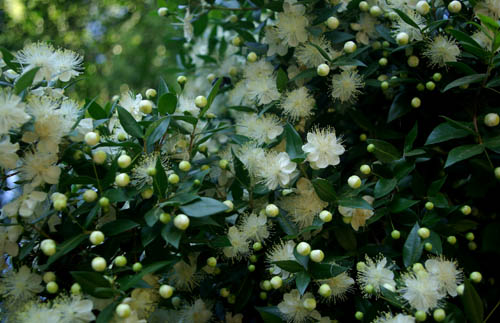
True myrtle is repeatedly referred to as a very old plant. It’s been with civilization for a very long time and is many times referred to in the Bible. It is most commonly associated with the Mediterranean region. In Greek mythology true myrtle is ascribed to have been sacred to Aphrodite, and, indeed, as Venus emerges from the sea, she is said to have hidden herself among the myrtle trees. In Rome Virgil states, “the poplar is most dear to Alcides, the vine to Bacchus, the myrtle to lovely Venus.” This was extended to the practice of women carrying myrtle in their bridal bouquets or of weaving wreathes of myrtle, worn in their wedding rituals. Frequent readers will not be surprised at all that this bit of information completely captured my imagination and I resolved immediately to make a wreath this morning, which I did, and enlisted the support of my very beautiful daughter to share the lovely result with all of you.

Indeed, it was Antonia who noticed immediately how beautifully fragrant the myrtle was when I gathered some yesterday morning and coupled with some pink hydrangea for a breakfast bouquet. It has a deeply spicey perfume emanating that is very rich and attractive. I do hope you will find some in your environs to enjoy. I also would encourage you to grow it, particularly for those of you who are water conscious as it proves to be not a fussy plant, and needing very little water, undoubtedly contributing to its longevity and easy survival. The one in my garden has been given free reign for a long time so it has become very large, indeed. Here you see just how much it has expanded over time. Conner wanted to be included in the frame. Enjoy.
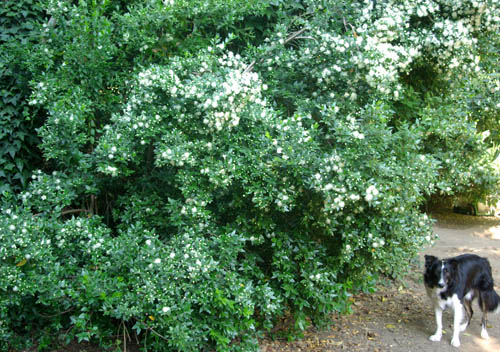
Love and many gardening blessings,
Kathryn xoxo
Posted on June 27th, 2009 by Kathryn
Filed under: Plants
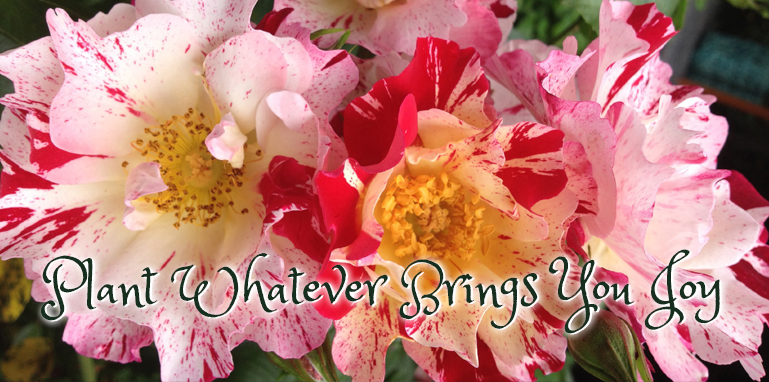
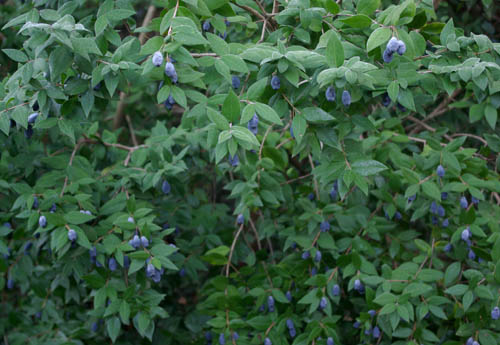







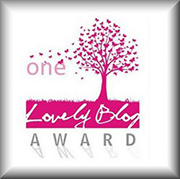


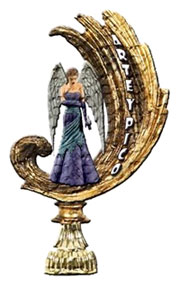

Love the picture of Antonia. Sounds like a very cool plant.
Good morning, Debbie! I bet it would do well in Texas! (Conversely, I’ve always wanted to try Texas sage up here!) Hope you will try it out. It’s so fragrant! Kathryn xoxo
What a Lovely history the myrtle has! Isn’t it Amazing how we can have such Blessings right there, unseen? Yes, it smells Wonderful and is a very Beautiful addition to bouquets! Great job with your wreathe making! 🙂
Love you,
Antonia
xoxox
Hi, Antonia! Thanks so much for adding so much to my post by modeling my wreath-work! Very kind of you, and very lovely, I must say! Glad you are enjoying this with me! Love, Mom xoxo
I have myrtle in my yard and it’s one of my favorites. One of the plants I greet, “ah, yes…I see you’re starting to flower again. You look lovely.” I didn’t know the berries were edible…that’s intriguing. Jeannie
Hi, Jeannie–I am so glad someone else has one of these! Isn’t the scent heavenly? As for the berries, I didn’t get the impression we would be inclined to pop them in our mouths like we traditionally might. I think they need to be used in some capacity. I’m trying to reconcile reading “jam” with “pepper.” But, hey! More to learn and explore! Thanks for stopping by! If you learn anymore, let us know, will you? Thanks.
Kathryn xoox
What a stunning bush! Thanks for sharing the pics and knowledge. I will keep an eye out in the future. So far all I have been to here are the big-box nurseries. Have not found an independent anywhere near me, but I will! As you are, I am the beneficiary of the previous owners, who loved to garden. Find treasures all the time.
Hugs,
CA
Good morning, CurtissAnn! 🙂 I do hope you will. It’s worth getting for the fragrance alone, let alone how pretty it is. I keep wondering how it is I’ve been on the planet this long and am just now learning what myrtle smells like! I get the feeling it’s a plant that was in vogue and somehow got set aside in favor of other plants. It needs to be brought back! So glad you are blessed with many plants in your new home. Isn’t it fun to discover what’s there? Kathryn xoxo
What an enchanting story! I loved reading this post. And especially enjoyed the photos of Conner and Antonia.
Hi, Kathlene! Thank you so much for the friendly visit! I’m glad you enjoyed the family photos! Love, Kathryn xoxo
Thank you for this post. Ever since I left the university I have longed for days in which I truly learned and studied something each day. In our culture of quick fix technology it is rare to get beyond the standard Wikipedia entry.
I remember growing up that my dear father used to have one of us haul out a tome (spelling?) of the huge encyclopedia that we owned. He would pick a topic that we had discussed that evening and then further our knowledge by reading to us!
So your entry just charmed me — both the content and the writing.
Welcome, Crayons! This is a lovely content and a good reminder of the value of sitting at the table with the family and conversing! How often does that happen by and large? Actually at the moment, in this house, every day! Most fortunately, I should add. Antonia and I had three books at the table yesterday, looking up asteroids and south and north nodes on our charts, trying to pin down Chiron on both. So fun, so funny! Yes, we both love learning! Kathryn xoxo
Thanks for the myrtle lesson, Kathryn.
Donna
Good morning Kathryn!
While enjoying “Plant” with a cup of coffee this morning, your post brought back a “scent memory” I had forgotten.
Years ago (it would have had to been before my twin brother and I were 8 when we moved to the coast) we lived in a small hot valley town that had been settled in the 19th century, and there was an old park we used to play in. A path shaded by old fragrant shrubs separated the tennis courts where my parents practiced and a playground. Since the playground was dusty and the metal swings were too hot to touch in the sun we made our own playground in the cool scented shrubbery; we seemed to have a great time and our imagination ran to jungles and forts. I am sure now from your post they had to have been old myrtles!
It is funny, but it is a though I can actually smell these fragrant plants with a memory from long ago.
Warm regards,
Philip
Hi, Donna, Thank you. Glad you enjoyed the “myrtle lesson”! 🙂 Kathryn xoxo
Hi, Philip, This is a wonderful memory! To have one’s childhood laced with a beautiful fragrance is a very good thing, indeed. Hopefully some moms out there will read this post and take note! I am still astounded it’s taken me all this time to discover it, and am grateful now for its presence in my life. I will make the effort to ensure that is always true. Thank you for sharing this lovely memory! Kathryn xoxo
Hi, Yael, I just googled “true myrtle” and found a nursery that sells it. Maybe you have to type in this name? Good luck! I can understand why you would want to do this! Kathryn xoox
Hi,
Last week I was on a mission to prune some tallow branches away from the theater building on the campus where I work. When I walked around the building I saw a new and lovely plant. None of the grons keepers knew exaCtly what it is so I took a cutting to the nursery across the street. The workers didn’t know it out of hand but they googled a few words and found that it’s common myrtle.
this lead me to this blog. Now I’m going to collect some berries and leaves for drying to use for cooking!
Thanks!
Treenail
Welcome, Treenail, It actually touches my heart that you left this comment, as it invites me to revisit this post, which somehow particularly endeared itself to me. I think because true (or common) mrytle, while admired for centuries, somehow now gets short shrift. Thanks for helping me bring it back! Kathryn xoxo
I am in need of Myrtle and I am curious if you would be willing to send a sprig or two to me? Please e-mail me. I would be greatly appreciative of your time.
Anyone in “need of myrtle” must have a special reason. Yes, I will email you, Erin. Kathryn xoo
Hi Kathryn, I enjoyed reading this. Have finally got around to hauling out the 17metres of garden privet (4 days tiring work). I was wondering, do you think common myrtle could succeed in a hedgerow? I was also wondering, being ever more conservation conscious these days, if the bush is popular with bumblebees? I don’t seem to have anything which flowers in late summer you see. Many thanks.
Hi, Jonathan, Liverpool and welcome! Glad you enjoyed the True Myrtle post. I’d say it’s moderately popular with bumblebees. i don’t think it’s your highest option. And knowing what I know from the myrtle that grows here I’d think twice using it as a hedge. I don’t think it would be happy. And I don’t think it grows close enough to itself to fill in. It likes to spread its wings and go rogue, actually. 🙂 I wonder if there’s any chance Texas sage would grow in the UK? Probably not, but BEES LOVE IT! You could check. 🙂 Kathryn xoxo
Thank you for your informative article. I purchased a couple of myrtus communis plants
a few years ago, wintered one plant over (St Louis) but they did not survive a third winter.
I am wondering if you know a nursery where I might purchase a few plants. They are
lovely as a small bush, aromatic and stately. My wife is a wedding minister, uses herbs in a head wreath as part of her ceremony , and incorporates herbs in her wreath. She used the myrtle when we had it – it was historically and symbolically very appropriate. I would appreciate any
source you might be able to recommend. Thank you for your posting.
— Bob LaRouche, St Louis
Hi, Bob, As the true myrtle was here when I got here and is probably decades old (and very large) I wouldn’t know where to begin to replace. I wish you the best and am glad to hear there are other fans. Kathryn xoox
I am so thrilled to learn about True Myrtle. I remembered my Daddy talking about making Persimmon Beer and using Pine Needles in the process. Got curious and “googled” Persimmon Beer and found out that wild Myrtle sprigs were used in making it—- baked sweet potatoes and cornbread were also ingredients; the green pine needles were used as a filter.. Then somehow I came upon your site and saw the picture of the blue berries..My son lives in the country and we have been seeing a shrub like plant with blue berries and could not identify it. I just bet it’s Wild Myrtle! Thanks for the article.
Hi, Jeanne, and welcome! I have a special place in my heart for True Myrtle, too, so I’m glad you share that enthusiasm. I wish more folks knew about it, since it was treasured for so very long. The Persimmon Beer story is fascinating! Kathryn xoxo
It seems your enthralled with myrtle. I too am looking to grow some. would you be able to send me a few sprigs or direct me to where I can buy established plants?
Avrohom
Hi, Avrohom, and welcome! Yes, I treasure it. I have no idea where to purchase it. Did you google? Where are you? Kathryn xoxo
I am in Brooklyn NY. I tried googling it but found it confusing. I also read that plants are easier to start from the seeds in the berries than from twigs. Do you still have berries on your bushes? Would you be able to mail me some seeds/berries?
Hi, Avrohom, Yes and yes. Leave your address as a comment. I won’t post. And I will put some berries in the mail for you. Let me know how it works. I did google, btw, and I found nurseries selling true myrtle (though the one I found was selling a smaller version). I didn’t look further. Good luck. And you’re welcome. 😉 Kathryn xoxo
Hi Kathryn, it’s so nice to meet you. I love your life story (the little bit I’ve read). This is my first time on your site. But I do have a true myrtle, it has bloomed but has not fruited yet. The way I found out what it was, I did take it to a nursery. My goal is to have fruit, but I have kept it around because it is in the Bible. I think I got the plant at the 99 cent store or it just popped up in my yard. Thank you for your blog.
Hi, Hope and welcome! I’m glad you have true myrtle in your garden and that you appreciate its ancient roots. Mine is just now beginning to get ripe fruit. I hope you find yours does the same. Kathryn xoxo